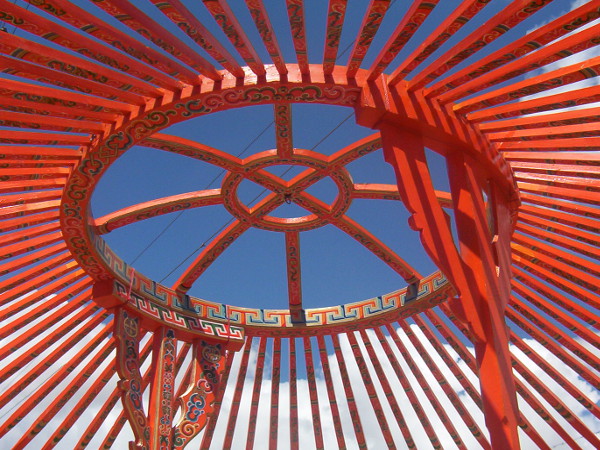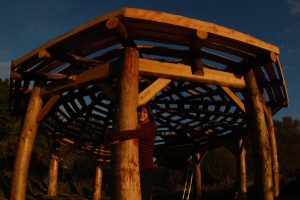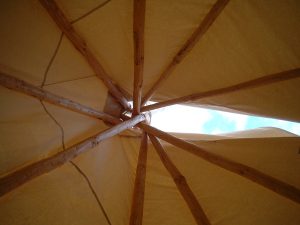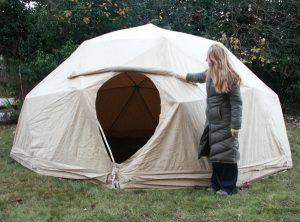Yurts / gers - introduction

“Genghis Khan commanded his entire empire from a ger.” – National Geographic
What are yurts?
The term yurt comes from the Russian word yurta. This in turn comes from a mistranslation of the yurt-dwellers word yurta, meaning home. The Mongols use the term ger, and the Turkic tribes refer to their yurts as oy or buzoy (pronounced ooh and buz-ooh).
Yurts as we know them today have been around for at least 1500 years. They evolved from the Siberian chum, a tent very similar to the North American tipi, firstly with the introduction of the wheel or crown known as the tunduk (a symbol of the great sky god Tengri) in the centre of the yurt, into which the roof poles are slotted. There are still tribes in the Azerbaijan / Iran border regions who live in structures like this, known as alachigs.

Yurt / ger in the wilds of Mongolia.
The next elaboration was the creation of the latticework walls (khana), which lifted the roof structure off the ground. The walls give the yurt more useful floor area, making the yurts more ergonomic as well as requiring shorter poles (easier to find and transport on the steppe) for the amount of space created in the tent.
Woven bands (terme) placed at the top of the wall act as a belt for the tent which keeps the yurt from collapsing outwards. Initially yurts were covered with animal skins, later skins were replaced with large sections of felted wool (alakyiz), but by the mid-twentieth century felt was replaced with quilted cotton canvas.

Top: wedding in a (very big) yurt. Bottom: self-built (very small) yurt.
Although in the West then, we use the word yurt and often think of Mongolian nomads, the Mongolian tent is called a ger and has a straight-poled roof and a heavy roof wheel; it handles strong winds very well and is sturdy. By contrast, the Kazakh-style yurt has curved roof poles.
Yurts come in lots of different styles and sizes, the smallest being 12’ (c. 4m) diameter, and the largest being up to 32’ (c. 10m) with three doors. There are also multi-span yurt-like tents, and yurts can be linked by bender structure tunnels, making them like joined pods.

Many of the homes in the suburbs of Ulan Bataar (capital of Mongolia) are yurts / gers.
Yurts were lived in across a vast area of Eurasia, from Turkey and the Ukraine to the suburbs of Beijing and from the Tibetan plateau in the south to the shores of lake Baikal in Siberia in the north. Today though, yurts are only still widely used in Mongolia and in a few scattered parts of western China, along with the former Soviet central Asian republics, where yurts are used as summer dwellings by pastoralists who migrate to high pastures with their flocks.
Stalin’s collectivisation policies effectively put an end to hundreds of years of all-year-round yurt living by the Turkic nomads. The emergence of the yurt in Europe and North America has been a relatively recent development in the history of this fantastic dwelling.

Yurt interiors can be very beautiful and cosy.
What are the benefits of yurts?
Like all structures, the evolution of the yurt reflects the environment in which it developed. A structure was required that could stand up to intense cold, heat and winds. It needed to be light enough to move around when required and to stand up without being anchored into the frozen ground or shifting desert sands.

Ornate door and central posts for a traditional Mongolian ger.
The wooden poles for the structure could all be harvested from the willow trees growing from the river banks of the steppe. The wool for the felts to cover and carpet the yurt was readily available from the nomads’ flocks of sheep and goats. Even the horse hairs were woven into the tent bands. The design and materials were part of the everyday life of the peoples who dwelt inside the yurts. Their homes, yurtas, were a living representation of their cosmology, and their relationship with each other, their animals and the land in which they lived.
A yurt is very cost-effective. Even if you buy one made by someone else you get a lot of space for your money.
Fast-motion video of the erection of a Mongolian ger
The materials for construction of a yurt can all be natural, low-impact materials or recycled. Either approach can make yurts a highly sustainable building solution. Along with this then comes the fact that yurt-making supports coppiced woodland management, and might also provide a market for wool and wool products.
Traditional yurts are breathable structures, pleasant to be in and good at coping with moisture. They are light, mobile, and relatively easy to erect.
Yurts can speak to the nomadic impulse in people, and their advocates talk of the spiritual aspect of yurt-living, seeing yurts as an ideal escape from the pressures of a high-tech society.

Self-build: making the crown.
What can I do?
Some yurt makers (like Guy, one of two yurt-makers interviewed for this introduction) will from time to time take volunteers to help in their work. This might be a good way to polish the skills needed to build your own yurt or to get an introduction to the craft. Quite a lot of yurt makers and yurt dwellers are self-taught: start with a good book and go from there!
Yurt-making courses are occasions to go through the whole process of yurt making, and to swap ideas in convivial company.
There are an increasing number of places offering the chance to spend time in yurts as an escape from day-to-day life. ‘Glamping’ in yurts is a good way to get a feel for yurt life, although it’s worth bearing in mind that a lovely summer stay in a yurt might not give you much of an idea what a grim February in the woods would be like.

Yurt-making workshops in Mongolia and the UK.
Yurt living is an accessible and affordable means to step outside of the housing problems of mainstream society. Exactly how feasible will depend on a number of factors, including local planning laws, but yurts are mobile and even if you find yourself having to move on, you will not lose your portable home. And of course a yurt might be an ideal extra room (possibly for a teenager?) for the garden.
The most commonly discussed problems of yurt living are climatic. As mentioned above, the yurt evolved to suit a very specific climate. It’s perfectly possible to use yurts in very wet climates, but the traditional form needs to be adapted. In Wales for example, and in the French Pyrenees, yurt-dwellers cover their yurts entirely with plastic to keep the rain out. A yurt in a wet climate then, would need a lining, insulation – traditionally felt, but now often more modern insulation material – and then a plastic overcoat. Even then many yurt makers would not advise living all-year-round in a yurt in a wet climate.

Yurt holidays are becoming more popular. Here’s a yurt with a view on an organic farm in Wales.
Yurt making involves a lot of knot-tying, and making the wall can be very hard on the hands. As with any woodworking, construction or self-build project, tool safety needs to be observed.
Yurt making and erection is not without its technical challenges: the mathematics of building a circular dwelling need thought; and whilst commercially-available yurt covers in heavyweight cotton canvas or polycotton are usually proofed against fire, water and rot, if you start with a reclaimed fabric, or a non-proofed cover you’ll need to address these challenges yourself.

Here’s a Mongolian family browsing our Facebook page in their ger.
Ongoing maintenance is as important to yurts as it is to any structure. The wooden frame will need to be oiled, probably every year with several thin coats of tung oil. Covers need to be checked over for rodent damage and wear – holes need to be patched with canvas. If your yurt cover is cotton it will need to be treated, Yurtworks recommend Nikwax and a 4” (10cm) brush. Of course, caps and windows need to be checked and maintained or replaced with time as well.
Specialist(s)
Thanks to Toby Fairlove of Fairlove Yurts & Guy Cutler of Fron Farm Yurts for information.
The specialist(s) below will respond to queries on this topic. Please comment in the box at the bottom of the page.





